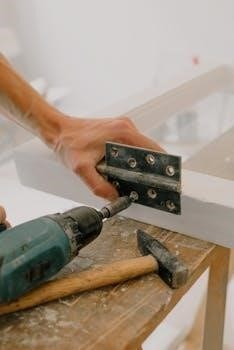Craftsman Riding Lawn Tractor Manual⁚ A Comprehensive Guide
This guide provides an overview of Craftsman riding lawn tractor manuals. These manuals contain crucial information on operation, safety, maintenance, and repair. They often include assembly instructions, troubleshooting tips, and parts diagrams. Owners should consult their specific model’s manual before use. It is important to have the right information about your tractor.
Understanding Your Craftsman Tractor Manual

Craftsman tractor manuals are essential resources for owners, offering detailed guidance on safe and effective operation. These documents typically begin with crucial safety warnings, emphasizing the potential risks associated with improper use. They also provide a comprehensive overview of the tractor’s various components, controls, and features. Familiarizing yourself with the manual’s organization and key sections is the first step towards responsible tractor ownership. The manuals often contain specific model numbers and instructions that are unique to your product, ensuring the most accurate information. Learning the correct terminology and understanding the diagrams can greatly enhance your ability to maintain and troubleshoot your machine. Sections on assembly, operation, and maintenance are often included with step-by-step instructions. Careful reading and reference to your manual can help prevent accidents, ensure proper performance, and extend the lifespan of your Craftsman riding lawn tractor. It’s also beneficial to keep your manual in a safe and easily accessible place for future reference, particularly during routine maintenance and any unforeseen operational issues. Knowing where to find the specific information you need will save time and effort.
Safety Precautions and Guidelines
Safety is paramount when operating a Craftsman riding lawn tractor, and the manual provides essential guidelines to minimize risks. Always read and understand all safety rules and instructions before starting the tractor. Never operate the tractor while under the influence of drugs or alcohol. Keep children and pets away from the operating area. Wear appropriate safety gear, including eye protection and sturdy footwear. Ensure the area is clear of obstacles such as rocks, tree limbs, and toys before mowing. Avoid mowing on steep slopes or near drop-offs, and mow up and down slopes, not across. Be extremely cautious when operating in reverse, and never carry passengers on the tractor. Never allow untrained individuals to operate the tractor. Regularly inspect the tractor for any loose parts or damage, and perform necessary maintenance. Always disengage the blades, set the parking brake, and turn off the engine before performing any adjustments or repairs. Pay close attention to the warnings and cautions outlined in the manual, and adhere to them diligently to prevent accidents and injuries.
Assembly Instructions for New Tractors
Craftsman riding lawn tractor manuals typically provide detailed assembly instructions for new tractors, as some parts are often left unassembled for shipping. Before beginning the assembly process, carefully unpack all components and verify that all listed parts are present according to the manual’s inventory. Ensure you have the necessary tools, such as wrenches, sockets, and screwdrivers, readily available. The manual will guide you step-by-step on attaching components like the steering wheel, seat, and mower deck. Pay close attention to the proper placement of washers and nuts, and tighten all hardware securely to prevent loosening during operation. The manual will also detail the procedure for installing the battery and connecting the electrical wiring. Before starting the tractor, double-check all connections and ensure the brake system is correctly adjusted. Take your time and carefully follow each step to ensure a safe and proper assembly. If you encounter any difficulties, consult the manual or contact a qualified technician for assistance. Proper assembly is crucial for the safe and efficient operation of your new Craftsman tractor.
Operation Procedures for Optimal Performance
To ensure optimal performance and longevity of your Craftsman riding lawn tractor, adhere to the operating procedures outlined in the manual. Before each use, perform a pre-start check, inspecting fluid levels, tire pressure, and the condition of blades. Familiarize yourself with the location and function of all controls, such as the ignition switch, throttle, choke, and attachment clutch lever. When starting the engine, follow the instructions in the manual, usually involving engaging the choke and turning the ignition key. Once started, allow the engine to warm up before engaging the mower blades. Always operate the tractor at the recommended speed for the terrain and grass conditions. Avoid abrupt starts, stops, and turns. When mowing, overlap each pass slightly to prevent scalping. Mow up and down slopes, not across. Do not mow in reverse unless absolutely necessary. After each use, clean the mower deck, and store the tractor in a dry, covered area. Following these guidelines will help you achieve the best possible results and extend the life of your Craftsman tractor.
Regular Maintenance Schedule and Tasks
Maintaining your Craftsman riding lawn tractor according to a regular schedule is essential for optimal performance and longevity. The owner’s manual provides a detailed maintenance schedule that should be followed closely. Typically, after the first few hours of use, you’ll need to change the engine oil and filter. Subsequently, oil changes are recommended every 25 to 50 hours, or annually. Regularly inspect and clean the air filter, replacing it as needed. Check the spark plug and replace it according to the manual’s recommendations. Lubricate all moving parts, such as steering linkages, and mower deck spindles, using the correct type of grease or oil. Inspect the blades for sharpness and damage, and sharpen or replace them as necessary. Check the tire pressure regularly. Clean the tractor, including the engine cooling fins and mower deck, after each use. Inspect the v-belts for wear and tension. Ensure that the battery terminals are clean and free of corrosion. Following the manual’s maintenance schedule will help prevent costly repairs and ensure reliable operation of your tractor.
Troubleshooting Common Issues
Craftsman riding lawn tractors, like any machinery, can encounter issues. The owner’s manual is an invaluable resource for troubleshooting these problems. Common issues include the engine not starting, which can be due to a dead battery, a faulty spark plug, or lack of fuel. If the engine starts but runs poorly, check the air filter and fuel lines for blockages. A common problem is the mower not cutting effectively, which could be caused by dull blades, an improperly adjusted mower deck, or a worn belt. If the tractor won’t move, check the drive belt and the transmission. Slipping belts can also lead to poor performance. Issues with the electrical system, such as lights not working, may be due to blown fuses or corroded connections. Always consult your manual for specific troubleshooting steps related to your model. When in doubt, seek assistance from a qualified technician for complex problems, and always ensure the tractor is off, and the keys are removed before performing any checks or repairs.

Adjusting the Mower Deck for Level Cuts
Achieving a level and consistent cut with your Craftsman riding lawn tractor requires proper adjustment of the mower deck. A misaligned deck can result in uneven grass height, scalping, or a poor overall cut quality. Begin by ensuring the tractor is parked on a level surface with the tires properly inflated. Consult your owner’s manual for the specific procedure for your model, as methods can vary. Typically, you’ll need to measure the distance from the bottom of the mower deck to the ground at various points, usually the front, rear, and sides. Adjust the deck using the adjustment points, often located on the deck’s hangers or lift links. The goal is to have the deck slightly lower at the front than the rear, which aids in efficient cutting and grass dispersal. After making adjustments, re-measure to confirm the deck is level. It is very important to take your time and double-check all the measurements to ensure a professional and even cut. Test the mower on a small area and make any additional tweaks as necessary. Always follow the safety instructions in your manual.
Brake System Inspection and Adjustment

Maintaining a functional brake system on your Craftsman riding lawn tractor is crucial for safety. Regular inspections and adjustments are necessary to ensure reliable stopping power. Begin by checking the brake pedal for free play and smooth operation. Refer to your tractor’s manual for the specific brake system components and their locations. Inspect the brake linkage, rods, and springs for any signs of damage, wear, or corrosion. If any parts appear worn or damaged, they should be replaced promptly. To adjust the brakes, often you’ll find an adjustment nut or rod near the brake pedal or at the brake mechanism itself. The goal is to achieve proper braking without excessive pedal travel. After making adjustments, test the brakes in a safe area to verify they are functioning correctly. If the tractor requires more than six feet to stop in the highest gear, further maintenance may be necessary. This could involve replacing the brake pads. Always consult your owner’s manual for specific adjustment procedures and safety precautions.
Replacing the Drive Belt
Replacing the drive belt on your Craftsman riding lawn tractor is a common maintenance task that ensures proper power transmission to the wheels. When the tractor struggles to move or the belt shows signs of wear, it’s time for a replacement. Before starting, consult your specific model’s manual for the correct belt routing and specifications. Disconnect the spark plug wire and engage the parking brake for safety. Typically, you’ll need to disengage the tensioner pulley to loosen the old belt. Note the precise path the old belt takes around all pulleys; take pictures if necessary to aid in reassembly. Carefully remove the old belt and install the new one, ensuring it is properly seated in all pulley grooves. Pay close attention to the tensioner pulley, making sure it applies the correct amount of pressure to the belt. Once the new belt is installed, double-check the routing against your manual and ensure all pulleys are aligned. Finally, reconnect the spark plug wire and test the tractor’s movement before resuming regular use. If you have doubts, seek guidance from a qualified technician.
Understanding Transmission Operations
Understanding the transmission of your Craftsman riding lawn tractor is crucial for optimal performance and longevity. Craftsman tractors often feature either a gear-driven or an automatic transmission, each with its own operating characteristics. Gear-driven transmissions require manual shifting between gears using a lever or pedal, offering precise control over speed and torque. Automatic transmissions, on the other hand, typically utilize a hydrostatic system, allowing for smooth, stepless speed changes through a single control. Familiarize yourself with your specific transmission type as it dictates how you operate the tractor. Ensure the motion control lever is in neutral before starting the engine. For gear-driven models, avoid abrupt shifting and always use the clutch when changing gears. Automatic models require a gentle touch on the speed control, avoiding jerky movements. Pay attention to any unusual noises during operation, which may indicate a problem. Proper maintenance, including checking fluid levels and following the manufacturer’s recommendations, is crucial for reliable transmission operation. Always refer to your manual for specific details and troubleshooting advice;
Electrical System Maintenance and Repair
Maintaining the electrical system of your Craftsman riding lawn tractor is essential for reliable starting and operation of all electrical components. This system generally includes the battery, starter, alternator, wiring harness, ignition switch, lights, and safety interlock switches. Regular checks of the battery terminals for corrosion and tightness are crucial. Ensure the battery is fully charged, especially after periods of non-use. Inspect the wiring for any damage, loose connections, or frayed insulation, which can lead to shorts or malfunctions. If your tractor has lights, check them regularly, and replace any burnt-out bulbs. Before attempting any electrical repairs, always disconnect the negative battery cable to prevent accidental shorts. Use a multimeter to test components, such as the ignition switch and safety switches, to diagnose issues. If you are not comfortable working with electrical components, seek professional assistance. Following the maintenance schedule in your manual, including keeping the battery terminals clean and the wiring protected, will help prevent problems. Always refer to your Craftsman manual for specific troubleshooting and wiring diagrams;
Locating Specific Model Manuals and Parts

Finding the correct manual and parts for your Craftsman riding lawn tractor is crucial for proper maintenance and repair. Start by identifying your tractor’s model number, usually found on a sticker under the seat or on the frame. With this number, you can often download a digital copy of the owner’s manual from the manufacturer’s website or trusted online resources such as ManualsLib. These manuals typically contain parts lists, diagrams, and detailed procedures specific to your model. For purchasing replacement parts, websites like Sears Parts Direct offer parts lookup tools, allowing you to find the exact components you need using your model number. When ordering, double-check part numbers to avoid errors; If you encounter difficulties, utilize customer support hotlines provided by retailers or the manufacturer for assistance. Always refer to your specific model’s manual for proper part identification and installation instructions. This careful approach ensures that you receive the right manual and parts, thus guaranteeing that your tractor is maintained in optimal condition.
